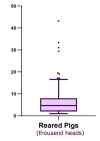The Use of Antimicrobials in Italian Heavy Pig Fattening Farms
- PMID: 33322049
- PMCID: PMC7764202
- DOI: 10.3390/antibiotics9120892
The Use of Antimicrobials in Italian Heavy Pig Fattening Farms
Abstract
Data on antimicrobial use (AMU) in heavy pig production (>150 kg) are limited. The aim of this study was to investigate the AMU in this production. Data from 2015 were collected for 143 fattening farms. The AMU was estimated through a treatment index per 100 days (TI100) using the defined daily dose animal for Italy (DDDAit). When possible, a comparison with the European Medicines Agency's defined daily doses for animals (DDDvet) was performed. The median TI100 was 10.7 (range, 0.2-49.5). Group treatments represented 94.6% of overall consumption. The AMU calculated using DDDAit and DDDvet were strongly correlated (ρ = 0.976; p < 0.001). The AMU was negatively correlated with injectables use (ρ = -0.46, p < 0.001) and positively correlated with oral products (ρ = 0.21, p = 0.014), premixes (ρ = 0.26, p = 0.002), and mortality (ρ = 0.18; p = 0.027). Farm size was negatively correlated with AMU (ρ = -0.29, p < 0.001). Smaller farms were more frequently above the median TI100 (odds ratio = 2.3, 95% confidence interval = 1.2-4.7), suggesting that they may have lower biosecurity and management standards. The results of this study should provide useful insights for the development of an Italian monitoring system.
Keywords: AMU; DDDAit; DDDvet; mortality; pig production; prudent use; swine.
Conflict of interest statement
The authors declare no conflict of interest.
Figures





References
-
- WHO Critically Important Antimicrobials for Human Medicine, 1th Revision. [(accessed on 2 June 2020)]; Available online: https://apps.who.int/iris/bitstream/handle/10665/43765/9789241595742_eng....
-
- WHO Critically Important Antimicrobials for Human Medicine, 6th Revision. [(accessed on 2 June 2020)]; Available online: https://apps.who.int/iris/bitstream/handle/10665/312266/9789241515528-en....
-
- European Surveillance of Veterinary Antimicrobial Consumption (ESVAC) Project Sales of Veterinary Antimicrobial Agents in 31 European Countries in 2018 (EMA/24309/2020) [(accessed on 6 November 2020)]; Available online: https://www.ema.europa.eu/en/documents/report/sales-veterinary-antimicro....

